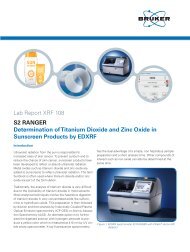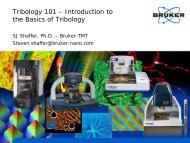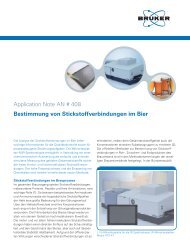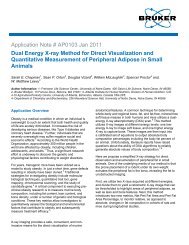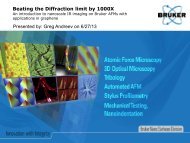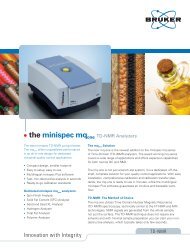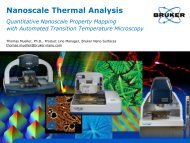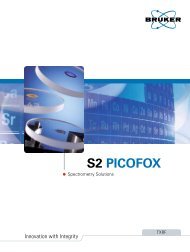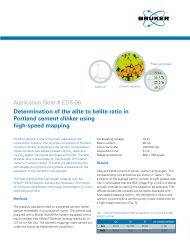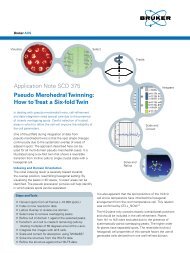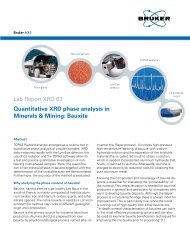Download the PDF copy - Bruker
Download the PDF copy - Bruker
Download the PDF copy - Bruker
You also want an ePaper? Increase the reach of your titles
YUMPU automatically turns print PDFs into web optimized ePapers that Google loves.
The Powerful Diversity of <strong>the</strong> AFM<br />
Probe<br />
Stefan B. Kaemmer, <strong>Bruker</strong> Nano Surfaces Division, Santa Barbara, CA 93117<br />
stefan.kaemmer@bruker-nano.com<br />
March 21, 2011
Introduction<br />
The tip allows us to measure a quantity. This quantity is based<br />
on what interaction <strong>the</strong> selected tip is sensitive to.<br />
• Surface topography<br />
• Molecular forces<br />
(Pulling, molecular recognition)<br />
• Nanomechanical information<br />
(PeakForce QNM)<br />
• Electrical information (CAFM,<br />
SCM, SPoM,…)<br />
• Optical information<br />
(Raman, IR, Fluorescence)<br />
• Thermal information<br />
(SThM, nTA)<br />
February 17, 2011 <strong>Bruker</strong> NanoSurfaces Division<br />
2
What do we cover in this talk?<br />
In order to get quality information one needs <strong>the</strong> right<br />
tools:<br />
• A high performance AFM,<br />
• The correct tip<br />
600 nm height image of Lambda DNA<br />
adsorbed onto a mica surface.<br />
(TappingMode TM in fluid.)<br />
500 nm phase image of E. coli S-layer<br />
membranes exhibiting <strong>the</strong><br />
characteristic 14nm lattice periodicity.<br />
(TappingMode TM in fluid.)<br />
45 mm<br />
180 mm image of Human<br />
endo<strong>the</strong>lial cells captured at 2k x<br />
2k pixel resolution. (Contact<br />
mode in fluid)<br />
February 17, 2011 <strong>Bruker</strong> NanoSurfaces Division<br />
3
Cantilever and beam bounce setup<br />
Amplification: B = 3s/l but ultimate sensitivity is independent of l and<br />
proportional to 1/s<br />
l: length of cantilever<br />
S: distance between detector and cantilever<br />
February 17, 2011 <strong>Bruker</strong> NanoSurfaces Division<br />
4
Where to find information about tips?<br />
www.<strong>Bruker</strong>AFMprobes.com<br />
February 17, 2011 <strong>Bruker</strong> NanoSurfaces Division<br />
5
Probe selection<br />
Imaging<br />
Environment<br />
AFM Mode<br />
Sample Type Probe Family/Model Liquid Air Tapping Contact Force<br />
Curves<br />
Biomolecules (nucleic<br />
acids, proteins, lipids,<br />
carbohydrates, etc)<br />
Silicon OTESPA - X X - -<br />
RTESP - X X - -<br />
TESP - X X - -<br />
Biolever X - - - X<br />
Etched Silicon Cantilever<br />
5-10 nm<br />
Biomolecules (nucleic<br />
acids, proteins, lipids,<br />
carbohydrates, etc)<br />
Silicon<br />
Nitride<br />
SNL X - X X X<br />
MSNL X - X X X<br />
NP-STT X - X X -<br />
Cells Silicon Biolever X - - X X<br />
Cells<br />
Silicon<br />
Nitride<br />
DNP X - X X X<br />
MLCT X - X X X<br />
Tissues Silicon TESP - X X - -<br />
Silicon Nitride Cantilever<br />
10 - 40 nm<br />
Tissues<br />
Silicon<br />
Nitride<br />
DNP X - X X X<br />
MLCT X - X X X<br />
SNL X - X X X<br />
MSNL X - X X X<br />
February 17, 2011 <strong>Bruker</strong> NanoSurfaces Division<br />
6
Example: Force measurements<br />
AFM is used for force measurements in pN (10 -12 N) range<br />
Approach<br />
Retract<br />
z<br />
• Hooke‘s law shows us that <strong>the</strong> force measured is directly<br />
proportional to <strong>the</strong> cantilever spring constant<br />
• So <strong>the</strong> solution is easy: Just make a super soft cantilever<br />
and have a go. Or not?<br />
February 17, 2011 <strong>Bruker</strong> NanoSurfaces Division<br />
7
Example: Force measurements<br />
February 17, 2011 <strong>Bruker</strong> NanoSurfaces Division<br />
8
Example: Force measurements<br />
J Hutter, J Bechhoefer, Rev. Sci. Instrum. 64 (1993)<br />
February 17, 2011 <strong>Bruker</strong> NanoSurfaces Division<br />
9
Example: Force measurements<br />
Example: OBL lever ―Biolever‖ (from <strong>Bruker</strong>AFMprobes.com)<br />
February 17, 2011 <strong>Bruker</strong> NanoSurfaces Division<br />
10
Tip functionalization<br />
Measure <strong>the</strong> specific interaction<br />
between a molecule attached to <strong>the</strong> tip apex<br />
(A) and ano<strong>the</strong>r one attached to a support<br />
(from atomically flat support to living cells) in<br />
(most of <strong>the</strong> time) a liquid environment.<br />
A<br />
A<br />
A<br />
A<br />
A<br />
A<br />
A A<br />
A<br />
A<br />
A<br />
A<br />
A A A A A A A A<br />
B B B B B B B B B B B<br />
February 17, 2011 <strong>Bruker</strong> NanoSurfaces Division<br />
11
Molecular Recognition Mapping<br />
Malaria-Infected Erythrocytes<br />
AFM Probe functionalized<br />
with endo<strong>the</strong>lial surface<br />
receptor CD36.<br />
• Malaria-infected RBCs (IE‘s) show<br />
different shape and appearance of<br />
knob-like surface structures.<br />
• ‗Knobs‘ believed involved in adherence<br />
to endo<strong>the</strong>lial cells<br />
Imaging of IE‘s with CD36 probe showed<br />
adhesion sites mapped to ‗knob-like‘<br />
structures.<br />
Li et al. WCB 2010.<br />
February 17, 2011 <strong>Bruker</strong> NanoSurfaces Division<br />
12
Mechanical Property Mapping – Live and<br />
dead cells<br />
PeakForce deformation channel<br />
February 17, 2011 <strong>Bruker</strong> NanoSurfaces Division<br />
13
Probe selection<br />
Imaging<br />
Environment<br />
AFM Mode<br />
Sample Type Probe Family/Model Liquid Air Tapping Contact Force<br />
Curves<br />
Biomolecules (nucleic<br />
acids, proteins, lipids,<br />
carbohydrates, etc)<br />
Silicon OTESPA - X X - -<br />
RTESP - X X - -<br />
TESP - X X - -<br />
Biolever X - - - X<br />
Etched Silicon Cantilever<br />
5-10 nm<br />
Biomolecules (nucleic<br />
acids, proteins, lipids,<br />
carbohydrates, etc)<br />
Silicon<br />
Nitride<br />
SNL X - X X X<br />
MSNL X - X X X<br />
NP-STT X - X X -<br />
Cells Silicon Biolever X - - X X<br />
Cells<br />
Silicon<br />
Nitride<br />
DNP X - X X X<br />
MLCT X - X X X<br />
Tissues Silicon TESP - X X - -<br />
Silicon Nitride Cantilever<br />
10 - 40 nm<br />
Tissues<br />
Silicon<br />
Nitride<br />
DNP X - X X X<br />
MLCT X - X X X<br />
SNL X - X X X<br />
MSNL X - X X X<br />
• Resonance frequency of probes in fluid drops to 1/2 -1/3 of <strong>the</strong> resonance frequency of <strong>the</strong> probe in air.<br />
• Resonance frequency in fluid easily identified through use of <strong>the</strong>rmal tune.<br />
February 17, 2011 <strong>Bruker</strong> NanoSurfaces Division<br />
14
Tapping Mode<br />
Newtons 2 nd law of motion<br />
Effective resonance<br />
frequency<br />
February 17, 2011 <strong>Bruker</strong> NanoSurfaces Division<br />
15
Tapping Mode<br />
Tapping Mode<br />
February 17, 2011 <strong>Bruker</strong> NanoSurfaces Division<br />
16
Lateral resolution<br />
• Smallest features that can be resolved<br />
• In optics it is determined by <strong>the</strong> spot size of <strong>the</strong> focused beam, in<br />
SPM by tip size and tip-sample distance<br />
Tip size -> What does <strong>the</strong> sample actually see of <strong>the</strong> tip? E.g. STM<br />
resolution is restricted to area of tip at which current changes less than a<br />
magnitude (CJ Chen. Intro to STM 1993) In force micros<strong>copy</strong> we have to<br />
look at <strong>the</strong> change in tip-sample interaction forces to define <strong>the</strong> lateral<br />
resolution.<br />
February 17, 2011 <strong>Bruker</strong> NanoSurfaces Division<br />
17
Why do we actually want to stay close to<br />
<strong>the</strong> surface?<br />
Lets take <strong>the</strong> example of electrostatic measurements.<br />
z<br />
r<br />
s<br />
x<br />
q<br />
Grounded tip away from a point<br />
charge q. The force on <strong>the</strong> tip will<br />
be F=f(x) with F max at x=0<br />
The force is a function of F(x,s,r). One<br />
can show that:<br />
Force<br />
DLat<br />
DLat is:<br />
• proportional to sqrt(r)<br />
• directly proportional to <strong>the</strong> tip-sample<br />
distance s.<br />
q1<br />
q2<br />
This is why you want to be close to <strong>the</strong><br />
surface and not far away like in noncontact<br />
for <strong>the</strong> highest lateral resolution.<br />
February 17, 2011 <strong>Bruker</strong> NanoSurfaces Division<br />
18
What tip do we need?<br />
We want to stay close but at <strong>the</strong> same time want to avoid <strong>the</strong> jump to<br />
contact.<br />
F Spring<br />
s<br />
F Total = F Spring - F Ext<br />
F Total (s)=0<br />
s<br />
F Ext<br />
s=0<br />
time<br />
So we need a tip with a high enough spring constant to avoid <strong>the</strong><br />
instability<br />
February 17, 2011 <strong>Bruker</strong> NanoSurfaces Division<br />
19
Resonance versus Sub-Resonance Tapping<br />
Cantilever<br />
Response<br />
F ~ s<br />
k<br />
Solution: k 0.1~ 0.4 N/m<br />
F<br />
~<br />
A<br />
Q<br />
s <br />
~ f<br />
Q<br />
<br />
Frequency<br />
k<br />
A0<br />
( A0 As ) k<br />
w ~<br />
Q<br />
w10x10 -18 Joule/cycle,<br />
for a tip with R~10 nm<br />
0<br />
<strong>Bruker</strong> NanoSurfaces Division<br />
February 17, 2011 20
Peak Force Tapping<br />
Trajectory of <strong>the</strong> tip<br />
1 nN<br />
approaching<br />
withdraw<br />
van der Waals<br />
Peak tapping force<br />
Time<br />
TESP (42 N/m) on Si, MM8<br />
February 17, 2011<br />
<strong>Bruker</strong> NanoSurfaces Division<br />
21
Resolution & Force Control<br />
C 60 H 122 Height<br />
Stress = 1.27 GPa<br />
1 nN<br />
C 36 H 74 Height<br />
Dia 1 nm<br />
C 18 H 38 Height<br />
80x80 nm<br />
500x500 nm<br />
10pN—1uN<br />
80x80 nm<br />
February 17, 2011<br />
<strong>Bruker</strong> NanoSurfaces Division<br />
22
True atomic resolution - Gibbsite in water<br />
1 x 1 um 2 topography image of<br />
gibbsite platelets on mica substrate<br />
Tapping mode topography (left) and phase<br />
image (right) of a gibbsite surface in pure water.<br />
Data taken on regular MultiMode-AFM using Fastscan B cantilever. Courtesy<br />
of F. Mugele and D. Ebeling, Univ. of Twente/NL.<br />
February 17, 2011 <strong>Bruker</strong> NanoSurfaces Division<br />
23
True atomic resolution - Mica in water<br />
Data taken on regular MultiMode-AFM. Courtesy of F. Mugele and D. Ebeling,<br />
Univ. of Twente/NL.<br />
February 17, 2011 <strong>Bruker</strong> NanoSurfaces Division<br />
24
Conclusion<br />
• Choosing <strong>the</strong> right cantilever for <strong>the</strong> job will unlock <strong>the</strong> full potential of<br />
your AFM<br />
• It is beneficial to make some rough estimates on what can be achieved<br />
with a given cantilever<br />
• Peak Force Tapping achieves extremely high resolution data in air due to<br />
superior force control and <strong>the</strong> ability to use soft cantilevers<br />
• By working in liquids Tapping Mode using small amplitudes can produce<br />
true atomic resolution data<br />
• High solution imaging: <strong>the</strong> sensitivity and even noise have been<br />
sufficient for a decade with Multimode IIIa<br />
I would like to thank my colleagues Andrea Slade, Steven Minne, James<br />
Shaw, and Chanmin Su for helpful discussions<br />
February 17, 2011 <strong>Bruker</strong> NanoSurfaces Division<br />
25



